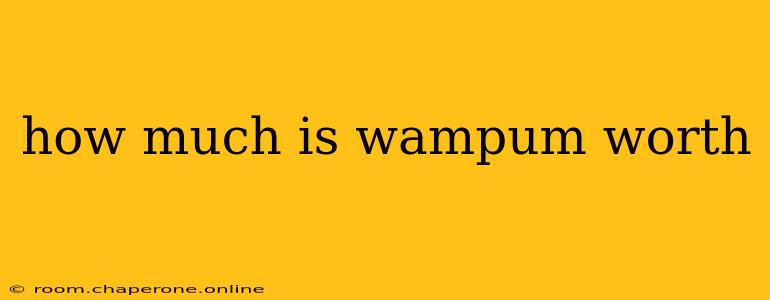Wampum, those meticulously crafted beads from the shells of quahogs and whelks, holds far more significance than just monetary value. For centuries, it served as a crucial element in the social, political, and economic structures of various Native American tribes in the northeastern United States and eastern Canada. Understanding its worth requires looking beyond a simple dollar figure and exploring its rich history and cultural importance.
The Historical Significance of Wampum
Before delving into potential monetary value, it's critical to acknowledge the deep cultural resonance of wampum. These weren't merely decorative beads; they were:
- Currency: Wampum functioned as a form of currency, used in trade and transactions for goods and services. The value varied based on factors like the type of shell, the size and quality of the beads, and the intricacy of the work.
- Diplomatic Tools: Wampum belts played a vital role in diplomacy, conveying messages, treaties, and agreements between tribes. The intricate designs often represented complex narratives and historical events. These belts held immense symbolic and historical weight.
- Religious Objects: Certain wampum pieces were used in ceremonies and religious practices, further solidifying their spiritual value.
- Status Symbols: The possession of wampum, particularly elaborate belts, indicated wealth, power, and prestige within a tribe.
Determining the Monetary Value: A Complex Equation
Assigning a monetary value to wampum is incredibly challenging, primarily due to its historical and cultural significance. There is no single, universally accepted price. The worth depends on several intertwined factors:
- Type of Shell: Quahog wampum, typically white or purple, was generally more valuable than that made from whelk shells, which were usually a darker color.
- Bead Size and Quality: Larger, perfectly formed beads commanded a higher price than smaller or irregularly shaped ones.
- Condition: The preservation state significantly impacts value. Wampum that is intact, with minimal damage or wear, is more valuable.
- Historical Significance: Wampum belts with known historical associations or depictions of important events are worth considerably more than simple strands of beads. Proven provenance (history of ownership) can dramatically increase value.
- Authenticity: The authenticity of a wampum piece is paramount. Counterfeits exist, and verifying authenticity requires expert examination.
Consequently, determining the current market value often requires appraisal by a specialist knowledgeable in Native American artifacts and history. Auction records can provide some indication of prices achieved for similar items, but individual pieces will always be assessed based on their unique characteristics.
Beyond Monetary Worth: Respecting Cultural Heritage
It's crucial to remember that assigning a monetary value to wampum often diminishes its deeper cultural meaning. Many tribes view wampum as a sacred and irreplaceable part of their heritage. The commercialization and acquisition of wampum should always be approached with respect for its historical and cultural significance. Consider seeking guidance from tribal representatives or museums specializing in Native American artifacts before buying or selling wampum.
Where to Learn More:
Further research into the history and cultural significance of wampum can provide a richer understanding of its multifaceted value. Museums with substantial collections of Native American artifacts are invaluable resources. Academic journals and books focusing on Native American history and material culture offer deeper insights into this fascinating subject.
Remember, the worth of wampum extends far beyond a simple price tag; it's a profound testament to the enduring cultural legacy of Native American peoples.

